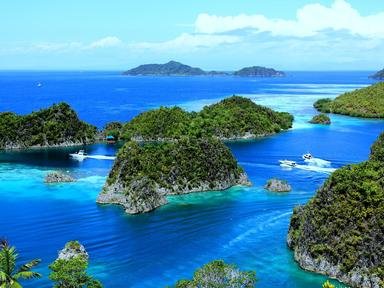Quiz Answer Key and Fun Facts
1. Our tour starts with a visit to the PNG National Mask Festival. After a two-and-a-half hour flight from Port Moresby to Rabaul/Kokopo, you will spend the evening in a hotel near Kokopo Beach, where the ceremony starts at sunrise the next day. Which island of Papua New Guinea will we be visiting today?
2. Flying back to the main island, we arrive in Port Moresby in time for the annual Hiri Moale Festival, which features these boats, called lakatoi. What was the original reason for this celebration of the Motu people?
3. Ready to leave Port Moresby? This morning we will be driving 50 km (30 mi) east to the town of Owers Corner. Here we will start our lengthy hike through the Owen Stanley Range, following in the footsteps of a famous World War II battle for the defense of Port Moresby by Australian soldiers. What is the name of the track along which we will be trekking?
4. From Kokoda we fly to Tufi, a coastal town located in the only fjord in Papua New Guinea, which is known for its fantastic diving and for an art form commonly found on a number of islands in the South Pacific. The picture shows an example of tapa, a textile made from which of these materials?
5. Goroka, the capital of the Eastern Highlands Province, is our next stop. It is the site of the nation's largest tribal gathering event, held every year near Independence Day, 16 September. What is the name for the traditional gathering to share dance, music, and other aspects of culture with nearby tribes?
6. We don't have to travel far from Goroka for our next stop. We will next be visiting the village of Asaro, where local tribesmen reenact a significant moment in their history, when the village was successfully defended against invading warriors who outnumbered the residents. This re-enactment has led to them being given which of the following nicknames?
7. Flying to Mt Hagen, capital of the province of Western Highlands, we then drive north to the Baiyer River Sanctuary, where we will stay at Kumul Lodge. This resort is named after the national bird of Papua New Guinea, of which you will see many specimens in the sanctuary. By what name is it usually known?
8. A short flight to Kundiawa will allow us to drive to the village of Keglsugl, from which we will start our four-day hike to the top of the tallest mountain in Papua New Guinea. Which of these is NOT a name for this mountain?
9. In the northern part of Papua New Guinea, the Sepik River is lined with tribal villages, with virtually no urban or industrial development. The people on these tribes are well known for which of the following activities?
10. The Huli people living in the Tari basin, part of the southern highlands of Papua New Guinea, are known for the elaborate headwear that they formerly donned for battle, and now wear primarily during ceremonial shows. What nickname has this led to?
Source: Author
looney_tunes
This quiz was reviewed by FunTrivia editor
stedman before going online.
Any errors found in FunTrivia content are routinely corrected through our feedback system.

